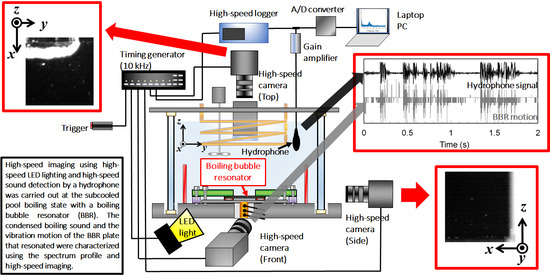Visualization and Sound Measurements of Vibration Plate in a Boiling Bubble Resonator
Abstract
:1. Introduction
2. Experimental Setup and Measurement Methods
3. Results & Discussion
3.1. Boiling Curves
3.2. Acoustic and Motion Spectra of the Vibration Plate
3.3. Instantaneous Acoustics and Motion of the Vibration Plate
3.4. Instantaneous Visualization of Microbubble Motion around the Vibration Plate
4. Conclusions
Author Contributions
Funding
Institutional Review Board Statement
Informed Consent Statement
Conflicts of Interest
References
- Unno, N.; Yuki, K.; Taniguchi, J.; Satake, S. Boiling heat transfer enhancement by self-excited vibration. Int. J. Heat Mass Transf. 2020, 153, 119588. [Google Scholar] [CrossRef]
- Unno, N.; Yuki, K.; Taniguchi, J.; Satake, S. Effect of the gap height between the vibration plate and heating surface on boiling heat transfer in a boiling bubble resonator. J. Therm. Sci. Technol. 2021, 16, JTST0017. [Google Scholar] [CrossRef]
- Unno, N.; Yuki, K.; Taniguchi, J.; Satake, S. Heat Transport Augmentation Using Vibration Material Excited by Boiling Bubbles for Heat Removal from Divertor. Fusion Sci. Technol. 2021, 77, 716–720. [Google Scholar] [CrossRef]
- Liang, G.; Mudawar, I. Review of pool boiling enhancement by surface modification. Int. J. Heat Mass Transf. 2019, 128, 892–933. [Google Scholar] [CrossRef]
- Singh, S.K.; Sharma, D. Review of pool and flow boiling heat transfer enhancement through surface modification. Int. J. Heat Mass Transf. 2021, 181, 122020. [Google Scholar] [CrossRef]
- Khan, S.A.; Atieh, M.A.; Koç, M. Micro-nano scale surface coating for nucleate boiling heat transfer: A critical review. Energies 2018, 11, 3189. [Google Scholar] [CrossRef] [Green Version]
- Bonjour, J.; Lallemand, M. Effects of Confinement and Pressure on Critical Heat Flux During Natural Convective Boiling in Vertical Channels. Int. Commun. Heat Mass Transf. 1997, 24, 191–200. [Google Scholar] [CrossRef]
- Cheng, L. Fundamental issues of critical heat flux phenomena during flow boiling in microscale-channels and nucleate pool boiling in confined spaces. Heat Transf. Eng. 2013, 34, 1016–1043. [Google Scholar] [CrossRef]
- Kawakami, K.; Sakamoto, S.; Tanigawa, H.; Tsuruta, T. A study on transition process to MEB by limiting boiling space. J. Therm. Sci. Technol. 2021, 16, JTST0004. [Google Scholar] [CrossRef]
- Kutateladze, S.S. Heat Transfer in Condensation and Boiling; Translation Series; AEC-tr-3770; U.S. Atomic Energy Commission: Washington, DC, USA, 1952.
- Ivey, H.J.; Morris, D.J. Critical heat flux of saturation and subcooled pool boiling in water at atmospheric pressure. In Proceedings of the International Heat Transfer Conference 3, Chicago, IL, USA, 7–12 August 1966; pp. 129–142. [Google Scholar]
- Unno, N.; Yuki, K.; Kibushi, R.; Suzuki, K. Advanced boiling cooling technology using a compact vessel with a low water level. Trans. Jpn. Inst. Electron. Packag. 2018, 11, E18-010-1–E18-010-6. [Google Scholar] [CrossRef] [Green Version]
- Tang, J.; Xie, G.; Bao, J.; Mo, Z.; Liu, H.; Du, M. Experimental study of sound emission in subcooled pool boiling on a small heating surface. Chem. Eng. Sci. 2018, 188, 179–191. [Google Scholar] [CrossRef]











Publisher’s Note: MDPI stays neutral with regard to jurisdictional claims in published maps and institutional affiliations. |
© 2021 by the authors. Licensee MDPI, Basel, Switzerland. This article is an open access article distributed under the terms and conditions of the Creative Commons Attribution (CC BY) license (https://creativecommons.org/licenses/by/4.0/).
Share and Cite
Ono, J.; Unno, N.; Yuki, K.; Taniguchi, J.; Satake, S.-i. Visualization and Sound Measurements of Vibration Plate in a Boiling Bubble Resonator. Fluids 2021, 6, 443. https://doi.org/10.3390/fluids6120443
Ono J, Unno N, Yuki K, Taniguchi J, Satake S-i. Visualization and Sound Measurements of Vibration Plate in a Boiling Bubble Resonator. Fluids. 2021; 6(12):443. https://doi.org/10.3390/fluids6120443
Chicago/Turabian StyleOno, Junichiro, Noriyuki Unno, Kazuhisa Yuki, Jun Taniguchi, and Shin-ichi Satake. 2021. "Visualization and Sound Measurements of Vibration Plate in a Boiling Bubble Resonator" Fluids 6, no. 12: 443. https://doi.org/10.3390/fluids6120443
APA StyleOno, J., Unno, N., Yuki, K., Taniguchi, J., & Satake, S.-i. (2021). Visualization and Sound Measurements of Vibration Plate in a Boiling Bubble Resonator. Fluids, 6(12), 443. https://doi.org/10.3390/fluids6120443






